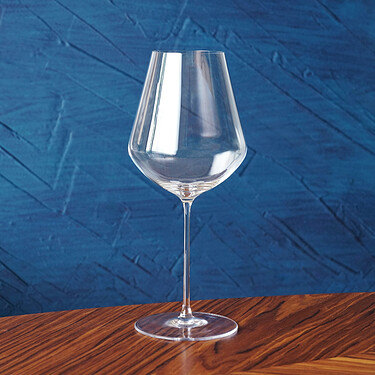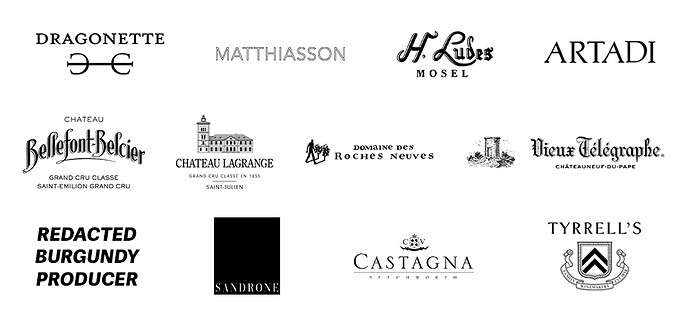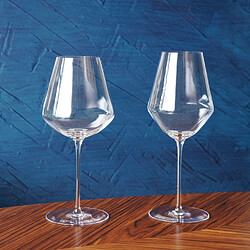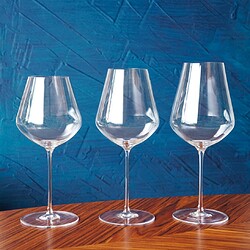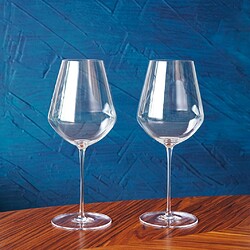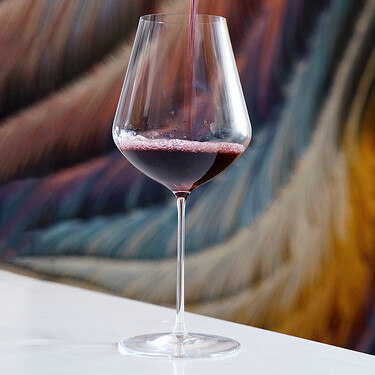PSA: Before we get into the story, this Berserker business you’ve all come to know as Bennuaine is now called Fontaine. If you want to know more about that, click here.
With the imminent launch of wine stemware (Update: It’s available now!), I wanted to share a little behind the scenes. The Wine Berserker community has been such an important part of the Fontaine story, and I thought you’d all might like a little nerdy dive into how the glass got made.
From Whiskey to Wine
When the Bennuaine spirits glass launched January 1, 2022, wine stemware was only the faintest consideration. I truly love wine, but the project was really all about spirits. The intent was that Bennuaine would be a niche side-business for many years before considering expanding.
Two years later, the requests asking for wine stemware were piling up - especially by the Berserkers. Initially I was a little hesitant because wine is very different from whisky and there was more business competition.
All that said, I love growth and am probably addicted to challenges, so off I went.
The Research Phase
Towards the end of 2023 I committed to this project and booked a trip to Bordeaux to kick things off. My modus operandi for design is all about making something that is highly functional, aesthetically beautiful, and delivers value to a wide range of people.
With a specific testing framework, I gathered as many glasses as I could and started research. This was a more arduous task than testing whisky glasses as there are so many grape varietals, blending styles, and tons of glass options. It was a very enlightening process to compare many pieces of glassware side-by-side. Some performed great for one varietal, others decent at many, some terrible at all. The primary aromas varied somewhat inconsistently from one brand to the next. It was also interesting to see and feel the differences in material quality, construction, and design.
Expert Opinions
No one knows wine better than the folks whose livelihoods depend on their skills and passion to understand and create it. So, I enlisted the help of some of my favorite wineries and sommeliers.
There is no way I would have ever thought legendary wineries in the USA, France, Italy, Spain, and Australia would share their time and expertise to test several prototypes, but here we are.
The wineries shown below participated in the development by receiving prototypes and providing feedback. An extremely well respected Burgundy producer politely requested they not be named but trust me you know them.
Master and Advanced sommeliers also contributed their expertise and insight into the project. All this feedback helped ensure that the glass was not just designed to enhance the wine, but also offered a functional and attractive glass for professional use.
There is so much talk about how subjective enjoyment is, but I think the testing process showed that there is less deviation in preferences than you might expect.
The Development
The first round of prototypes...
tested for the ideal width. Two designs were created at what I believed to be both the extreme widest and narrowest potential candidates for a universal glass. The wide design had 23% more surface area compared to the narrow..
Unsurprisingly, bold Cabernet Sauvignon wines tested very positively in the large design and acidic whites in the narrower design. Surprisingly many non-Cab reds also tested well in the narrow design with more fruit forward notes. Most surprising and exciting was that champagne and sparkling wines showed well in both prototypes. The consensus was clear that, for a Universal design, slightly wider than the median would be ideal. That surface area width equals 13% larger than the narrow. Additionally, it seems that the larger prototype is a very great starting point for a Burgundy style glass and the narrow for acidic mineral white or sparkling wines.
.
The second round of prototypes...
tested for the height of the glass, which increases both total volume as well as the nose-to-wine distance.The width and bottom portion of the glass were determined from the first round survey results. The tallest glass was 20mm taller and had 35% more volume compared to the shortest variant..
What was somewhat shocking was that there was a definitive preference for the taller prototype. Unlike the wide and short glasses which worked slightly better or worse depending on the varietal or style, there was no preference variance between the tall and short. The short glass made all wines too dense and concentrated. The nosing experience was definitely interesting, but not something you’d want for a Universal design. The tall glass on the other hand made wines more ethereal. We also tested a third design of middle height, and this was almost the Goldilocks zone, but we felt that a touch taller would be ideal. This middle height had 20% more volume than the shortest. Rarely is a test so conclusive, and I could not have been more relieved. Consensus definitely makes the design job easier.
The third round of prototypes...
tested the diameter of the rim. The range was a maximum of 64 and a minimum of 58, meaning the larger diameter had a 22% larger surface area..
Even though the numerical differences between Round 2 and Round 3 seem small, literally just a few millimeters, the changes were definitively notable. There’s talk from some folks who doubt the effects of small changes in glassware design, but I think the results prove even a couple millimeters make a big difference.
The results could only best be described as “wobbly”. The marginal gains made by pushing the limits of the design by increasing height and rim diameter were not worth the inconsistent performance. A diameter of 60 performed very well for everything, so that’s what we stuck with.
The Final Design
My various partners and I tested hundreds of both still and sparkling, as well dry and sweet wines over 8 months of development.
To get granular, that included at least 29 single varietal wines I could track and even more regional styles and blends. That list only scratches the surface of every single grape and blend that may exist in the entire world, but we tackled more than enough to have an abundance of confidence in the final product.
So much feedback and consideration has gone into making sure the glass is beautiful and functional.
The widest width of the glass is about 4.5oz. This size was determined so that the glass would work best for full pours and very well for smaller tasting pours too. The curvature of the bowl allows light to pass through the wine, highlighting all the vibrant color you want to see. A final push from Charlie Fu and his brother Wilbur convinced me to make the footplate a little larger to dial in the perfect handfeel and swirlability for the glass. For aromatics, the profile is very well balanced for both red and whites - reducing ethanol while retaining an appropriate amount of concentration in comparison to the higher more nuanced notes. Wines are delivered mid-palate and flavor blossoms outwards with very minimal back-of-jaw tingling from acid and tannin (something that plagued many glasses during testing). The weight of this Titanium Crystal stem (same quality as the spirits stem) will average 95 grams.
Learnings
While designing the wine glass, I consumed more wine in a condensed time frame than ever before in my entire life. It’s really wonderful to discover that the more hours I put into learning about wine, the more I enjoy it. Over the course of research and development, I would say the greatest wine revelation for me was vintage Rioja and it will be fun to dive deeper into that wine cave.
Compared to the spirits glassware, the path to a great design felt a little less clear at the start. With wine, there were so many things to consider. Paying attention to how tasting notes changed, not necessarily for better or worse, but in more subtle ways regarding aroma or palate details showed there was more room for interpretation of what a great glass does for wine.
Conclusion
The end result is a glass that I believe offers an exceptional experience for the majority of drinking situations.
If you’re only consuming 1 ounce at a time, and specifically using the glass to analytically evaluate the wine and seek out its flaws, this might not be right for you. But I think the vast majority of wine drinkers are looking for a glass that can be used everyday to enjoy a large variety of wine from, and for that use case I strongly believe this glass really delivers.
To close, the most shocking discovery was made at the very end of this development journey, literally as I was writing the final paragraphs and looking for a tidy way to sum everything up.
With the Universal wine glass design done and dusted, finely polished and ready to go into production, I wondered “how does the wine shape compare to the spirit shape?” So I hopped into my drafting software, scaled up my spirits glass to the width of the wine glass and discovered… The design was essentially the exact same. If you chop off the lip flare, it is 99.5% the same design. From the length of the stem, to the proportions of the bowl, to the taper and height of the top cone, it is the same glass.
To say this discovery was enormously shocking would be understatement. Maybe it shouldn’t be shocking. Maybe it’s obvious that through some boozy grand design they should correlate. In hindsight, I realize I never scaled up the spirit glass design when I first started sketching wine glasses. That should have been the first thing I did, not the last. Regardless, the connection between these two glasses is an apt throughline for the story. It’s pretty cheesy, but this business has been so full of beautiful and unexpected moments and I’m forever grateful. To accidentally end right where we began is as perfect denouement as I could ever imagine.
Thanks for being a part of this journey.
Cheers to all the wine you may enjoy from this glass.
And, as always, I’m always open to whatever questions you might have!
